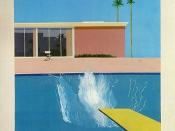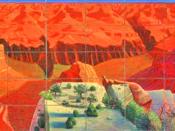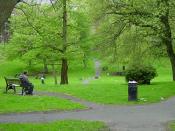David Hockney's works of art leave the viewer with questions which can only be answered within the works. His works are far from simple, for Hockney leaves the viewer with only hints. Such questions arise as whom are we in relation to these largely unpopulated canvases, which represent the products of human life but also speak of human participation so indirectly. Even when covering a canvas with a mass of exciting reds and yellows, Hockney leaves a sense of cool indifference, a visual product of carefully flattened internal perspectives.
His works of figurative landscape painting are far distant from painters who sought to transport viewers into the natural world of intertwined geology and botany. Rather, Hockney's works portray American landscape as a dramatic design that restates and moves scenes forward in planar perspective.
In Hockney's world, humanity has shrunk vastly. His idea was that one could stand atop a cliff with a magnificent view, but the enchantment of symbolic grandeur would be nowhere to be found.
In his Grand Canyon paintings, there is an obstruction so extreme that compresses the immense abyss into a visual summarization. In "A Bigger Grand Canyon" (Wikipedia), the sky has been limited to a thin blue band at the top so as not to betray this format. In "A Closer Grand Canyon", where Hockney does include the Arizona sky, his compositional choice seems largely a response to the challenge of flattening that too. Both paintings are composed of arrayed smaller canvases that emphasize optical mechanics based on photography, which captures these Grand Canyon mural-pictures in the form of draft collage assembly. The difference in effect can be understood by comparing these two Hockney works with Ed Mell's Grand Canyon series, where subtle chromatics and play of light combine within a modernist visual vocabulary that...


